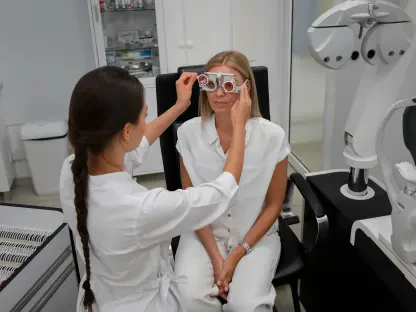The nursing profession is facing an escalating crisis due to high demands, overwhelming documentation requirements, and inefficient workflows. These factors contribute significantly to nurse burnout and turnover rates. Integrating AI-driven solutions can potentially mitigate these challenges, provided that nurses are involved in the innovation and design process from the get-go.
Understanding the Extent of the Nursing Workforce Crisis
The Looming Shortfall of Nurses
The healthcare sector is staring down the barrel of a staggering nurse shortfall by 2030, with projections from the World Health Organization (WHO) indicating a deficit of 4.5 million nurses. This alarming statistic not only underscores the urgent need for technological solutions to alleviate the burdens faced by nurses but also highlights the critical role these professionals play in maintaining healthcare systems globally. Without immediate intervention, this shortfall risks severely compromising the quality of patient care and overburdening the existing workforce, leading to even higher rates of burnout and turnover.
The ramifications of such a shortfall extend beyond patient care to influence the overall stability and efficiency of healthcare institutions. With an insufficient nursing workforce, hospitals and clinics may struggle to maintain adequate staffing levels, resulting in longer wait times, lower patient satisfaction, and potentially higher rates of medical errors. This scenario creates a vicious cycle where increasing demands on the remaining nurses drive further attrition, exacerbating the shortage. Therefore, addressing this crisis with innovative technological solutions is not merely an option but a necessity to ensure the sustainability of healthcare services.
Factors Driving Nursing Burnout
Burnout among nurses is driven by various factors, with excessive documentation and inefficient workflows standing out as significant contributors. Nurses often find themselves inundated with non-patient care tasks, ranging from meticulous record-keeping to navigating complex bureaucratic processes. This overwhelming administrative burden detracts from the core of their profession—providing direct patient care. The relentless workload can lead to job dissatisfaction, emotional exhaustion, and ultimately higher turnover rates, which further strains an already overburdened system.
Addressing these pain points is crucial for improving both nurse retention and overall job satisfaction. Streamlined workflows and reduced documentation are essential to not only enhance efficiency but also restore the sense of purpose and fulfillment that many nurses derive from their work. By leveraging AI-driven solutions to automate routine tasks, nurses can reallocate their time and energy towards patient care, thereby fostering a more supportive and rewarding work environment. This, in turn, could lead to improved patient outcomes, as nurses remain more engaged and attentive to the needs of those they care for.
The Imperative of Nurse-Centric Technology Design
Collaborating with Nurses on Technology Solutions
Leaders in the healthcare sector, such as Lea Ann Arnold and Terry McDonnell, stress the critical importance of involving nurses directly in the technology development process. The success of AI solutions hinges on this collaboration, as frontline nurses possess a nuanced understanding of their daily workflows and the practical challenges they face. By co-designing these solutions with nurses, technology developers can ensure that the innovations are not only theoretically sound but also practically applicable and genuinely beneficial in the nursing context.
This collaborative approach fosters a sense of ownership and trust among nurses, as they see their insights and feedback being valued and integrated into the final product. It also helps to bridge the gap between technology developers and end-users, leading to solutions that are more intuitive and user-friendly. The ultimate aim is to create technologies that complement rather than complicate the nursing role, enabling nurses to perform their duties more efficiently and with greater satisfaction. This alignment of technological capabilities with practical needs is essential for the successful integration of AI into nursing workflows.
Practical Insights from Nursing Workflow
Nurses offer invaluable insights into the daily logistics and challenges of their roles, making their input vital for creating user-friendly and genuinely beneficial technology. Their firsthand experience provides a detailed understanding of the practical aspects that technology must address to be effective. For instance, nurses can indicate specific documentation processes that are particularly time-consuming or identify workflow bottlenecks that impede efficiency. Such practical insights are crucial for designing AI solutions that are tailored to the real-world dynamics of nursing practice.
Involving nurses in the development process also ensures that the technology serves to augment their work rather than adding additional layers of complexity. By focusing on user-centered design principles, AI solutions can be made more accessible and easier to integrate into existing workflows. This approach not only enhances the usability of the technology but also increases its acceptance and adoption among nurses. Ultimately, the goal is to create AI-driven tools that empower nurses, allowing them to focus more on patient care and less on administrative tasks, thereby improving both job satisfaction and patient outcomes.
AI’s Potential to Revolutionize Nursing Tasks
Augmenting, Not Replacing Human Elements
AI technologies should be developed to support, not replace, the human aspects of nursing. By automating routine and mechanical tasks such as documentation, AI can free up nurses to spend more time on direct patient care, thereby enhancing the quality of care delivered. This augmentation allows nurses to focus on the more nuanced and compassionate elements of their profession, which are irreplaceable by technology. The human touch, empathetic communication, and critical thinking that nurses provide are essential components of effective patient care, and AI should serve to enhance these elements rather than diminish them.
Lea Ann Arnold emphasizes the importance of understanding AI’s role in augmenting nursing tasks, suggesting that technology can handle the more repetitive aspects of their work. By taking over tasks that are often seen as burdensome, AI enables nurses to engage more fully with their patients, fostering better relationships and improving patient experiences. This strategic use of AI not only alleviates some of the pressures nurses face but also enriches the overall care environment, making it more humane and patient-centered. Thus, the integration of AI holds the promise of a more balanced and fulfilling nursing practice.
Examples of AI in Nursing Workflows
One of the notable examples of AI in nursing workflows is the application of ambient technology, which has already proven successful in physician documentation. This technology is now being transitioned to nursing workflows, aiming to significantly reduce the duration and complexity of documentation tasks. By using natural language processing and other advanced algorithms, ambient technology can automatically capture and document interactions between nurses and patients, thereby streamlining the record-keeping process. This innovation allows nurses to dedicate more time and attention to patient care, which is the cornerstone of their profession.
Additionally, ambient technology can facilitate better data management and accuracy, as it minimizes the risk of human error in documentation. This ensures that patient records are up-to-date and precise, which is crucial for effective treatment and care coordination. By reducing the administrative burden on nurses, ambient technology not only enhances their efficiency but also improves their job satisfaction. The transition of such proven technologies to nursing workflows illustrates the potential of AI to create more streamlined and effective healthcare environments, ultimately benefiting both nurses and patients.
Microsoft’s Role in Healthcare AI
Microsoft’s Commitment to Healthcare AI
Microsoft has demonstrated a strong commitment to leveraging AI in healthcare, focusing on creating industry-specific solutions that seamlessly integrate into existing workflows. Their multi-year journey includes pilot programs across numerous healthcare institutions to fine-tune AI technologies. These pilot programs aim to address specific challenges in nursing workflows, particularly around documentation and administrative tasks. By collaborating closely with healthcare providers, Microsoft seeks to develop AI solutions that are not only innovative but also practical and effective in real-world settings.
The company’s approach involves continuous learning and adaptation, with feedback loops built into their development process. This ensures that the AI tools are constantly being improved and refined based on the experiences and insights of actual users. Microsoft’s commitment to healthcare AI reflects a broader strategy of harnessing the power of technology to solve pressing issues in the industry. By focusing on the needs of nurses and other frontline healthcare providers, the company aims to create solutions that enhance efficiency, reduce burnout, and ultimately improve patient care.
Collaborations with Leading Healthcare Organizations
Collaborations with leading healthcare institutions like Advocate Health, Duke Health, and Stanford Health Care have been crucial in refining Microsoft’s AI tools. These partnerships involve real-world deployment of preview technologies to gather actionable feedback from frontline nurses. By working closely with these institutions, Microsoft can test and adapt their AI solutions in diverse healthcare environments, ensuring that they are robust and versatile. The real-world input from nurses helps to identify both the strengths and limitations of the technology, guiding further development and optimization.
These collaborations also provide valuable case studies and evidence of the efficacy of AI solutions in nursing workflows. By documenting the impact of these technologies on efficiency, job satisfaction, and patient care, Microsoft and its partners can build a compelling case for wider adoption. The goal is to create AI tools that not only address immediate pain points but also contribute to long-term improvements in the healthcare system. The feedback gathered from these collaborations is indispensable for continuous innovation and refinement, bringing the vision of a more efficient, AI-powered nursing practice closer to reality.
Ensuring Continuous Innovation and Refinement
Gathering Feedback for Continuous Improvement
Feedback from nursing leaders such as Gretchen Brown and Tammy Daniel has been indispensable in the development and refinement of AI tools. Their firsthand experiences provide a grounded perspective on the benefits and limitations of AI technologies, guiding the ongoing development to better address the needs of the nursing workforce. This real-world feedback is invaluable for identifying areas where AI can be most effective and for making necessary adjustments to enhance usability and effectiveness. Engaging frontline nurses in the feedback process ensures that the technology remains relevant and aligned with the practical realities of nursing practice.
Continuous improvement through feedback loops is essential for the successful integration of AI in nursing workflows. As nurses use these AI tools in their daily routines, their insights help to uncover any issues or opportunities for enhancement that may not have been apparent during the initial development phases. This iterative process of refinement ensures that the technology evolves in response to the changing needs and challenges of the healthcare environment, ultimately leading to more robust and effective solutions. By prioritizing nurse feedback, developers can create AI tools that truly support and empower the nursing workforce.
Focus on Addressing Immediate Pain Points
The nursing field is grappling with a growing crisis, driven by high demands, extensive documentation requirements, and inefficient workflows. These issues are leading to significant nurse burnout and increased turnover rates. The demanding nature of nursing work today means that nurses are often overwhelmed by the volume of tasks they need to manage, from patient care to administrative duties. This overload not only affects their mental and physical health but also diminishes the quality of patient care and overall efficiency in healthcare settings.
Implementing AI-driven solutions has the potential to address these pressing challenges by streamlining workflows and reducing the burden of documentation. However, it is crucial that nurses are actively involved from the beginning in the development and design of these technologies. Their firsthand experience and insights can ensure that the AI solutions are practical, user-friendly, and truly beneficial in easing their workload. By doing so, we can create a more sustainable and satisfactory working environment for nurses, ultimately improving patient care and reducing nurse attrition.









